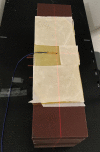Effects of variable-width jaw motion on beam characteristics for Radixact Synchrony®
- PMID: 33779041
- PMCID: PMC8130229
- DOI: 10.1002/acm2.13234
Effects of variable-width jaw motion on beam characteristics for Radixact Synchrony®
Erratum in
-
Erratum: "Effects of variable-width jaw motion on beam characteristics for Radixact Synchrony®".J Appl Clin Med Phys. 2023 Mar;24(3):e13883. doi: 10.1002/acm2.13883. Epub 2023 Feb 16. J Appl Clin Med Phys. 2023. PMID: 36795379 Free PMC article. No abstract available.
Abstract
Purpose: Radixact Synchrony corrects for target motion during treatment by adjusting the jaw and MLC positions in real time. As the jaws move off axis, Synchrony attempts to adjust for a loss in output due to the un-flattened 6 MV beam by increasing the jaw aperture width. The purpose of this work was to assess the impact of the variable-width aperture on delivered dose using measurements and simulations.
Methods: Longitudinal beam profile measurements were acquired using an Edge diode with static gantry. Jaw-offset peak, width, and integral factors were calculated for profiles with the jaws in the extreme positions using both variable-width (Synchrony) and fixed-width apertures. Treatment plans with target motion and compensation were compared to planned doses to study the impact of the variable aperture on volumetric dose.
Results: The jaw offset peak factor (JOPF) for the Synchrony jaw settings were 0.964 and 0.983 for the 1.0- and 2.5-cm jaw settings, respectively. These values decreased to 0.925 and 0.982 for the fixed-width settings, indicating that the peak value of the profile would decrease by 7.5% compared to centered if the aperture width was held constant. The IMRT dose distributions reveal similar results, where gamma pass rates are above tolerance for the Synchrony jaw settings but fall significantly for the fixed-width 1-cm jaws.
Conclusions: The variable-width behavior of Synchrony jaws provides a larger output correction for the 1-cm jaw setting. Without the variable-aperture correction, plans with the 1-cm jaw setting would underdose the target if the jaws spend a significant amount of time in the extreme positions. This work investigated the change in delivered dose with jaws in the extreme positions, therefore overall changes in dose due to offset jaws are expected to be less for composite treatment deliveries.
Keywords: radixact; synchrony; tomotherapy.
© 2021 The Authors. Journal of Applied Clinical Medical Physics published by Wiley Periodicals LLC on behalf of American Association of Physicists in Medicine.
Conflict of interest statement
The authors have no conflicts of interest to disclose.
Figures





References
-
- Chao EH, Lucas D, Schnarr E. Evaluation of TomoTherapy dose calculations with intrafractional motion and motion compensation. Med Phys. 2018;45:18–28. - PubMed
-
- Schnarr E, Beneke M, Casey D, et al, Feasibility of real‐time motion management with helical tomotherapy. Med Phys. 2018;45:1329–1337. - PubMed
MeSH terms
LinkOut - more resources
Full Text Sources
Other Literature Sources
Research Materials

